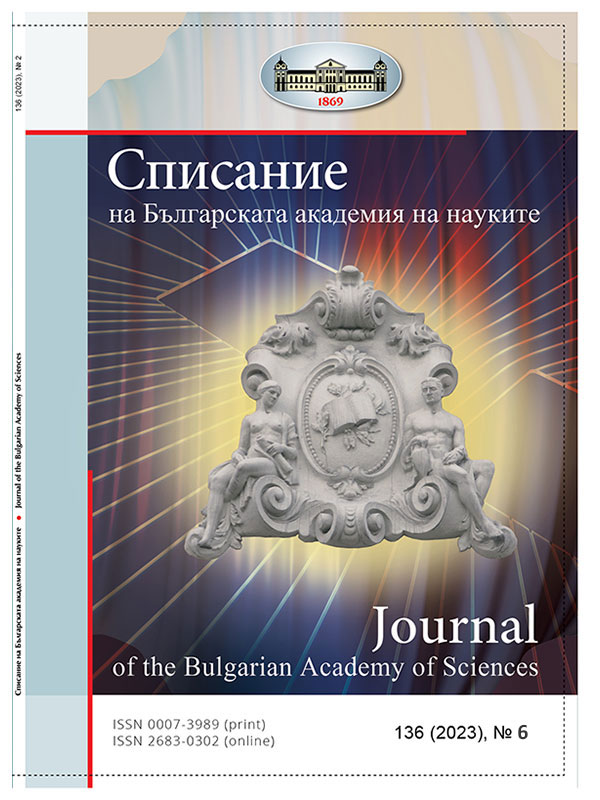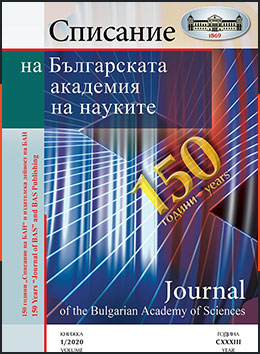Journal View
Journal of the Bulgarian Academy of Sciences
- Year: 2023
- Number: 6
- Language: Български, English
- Download Issue

- The Bulgarian Academy of Sciences Celebrated 154 Years since Its Establishment
- Speech of the President of BAS Academician Julian Revalski
-
Modern Patriotism in Our Country
Author(s): Petar Stoyanovich
- Celebration of the Day of the Enlighteners
-
Enlightenment as a Vocation
Author(s): Alexandra Milanova
- Awards for Scientists of BAS on the Day of the Enlighteners
-
Cooperativity in Chemistry and Biology. I. Hemoglobin and Cooperativity – One of the Enigmas of Life
Author(s): Christo B. TsvetanovAbstract: Cooperative binding is a key mechanism underlying a large range of biochemical and catalysis processes. It is a central concept for understanding molecular recognition, signal processes and supramolecular selfassembly. Cooperativity arises from the interplay of two or more reversible interactions, so that the system as a whole behaves differently from expectations based on properties of the individual interactions acting in isolation. In other words, cooperativity is a type of behavior where a number of seemingly independent components of a system act collectively. The main object of cooperativity in the present review is allostery a process by which biological macromolecules transmit the effect of binding at one side to another, often distal. The phenomenon of cooperativity was initially observed in the oxygen – hemoglobin interaction that functions in carrying oxygen in blood. Here, the key concepts of cooperative oxygen binding by hemoglobin are presented, the paradigm of structure function relations in multisubunit proteins. Oxygen – hem group interaction triggers conformational changes in hemoglobin so that oxygen binds to the protein cooperatively, yielding a sigmoidal binding curve. Particular attention is paid to the most popular and generally accepted Monod, Wyman, and Changeux НАУЧЕН ДЯЛ 6/2023 Списание на БАН 23 (MWC) model. MWC model implies that the entire protein associate can undergo conformational transition even when it is partially liganded (T and R quaternary structures, which exhibited low and high O2 affinity, respectively). Perutz interpreted the two-state MWC model on a stereochemical basis. According to his studies it is an equilibrium between two alternative structures, a tense one (T), constrained by salt-bridges between the C-termini of the four subunits, and a relaxed one (R) lacking these bridges. The interest in studying the phenomenon of cooperativity continues to be strong due to the recent experimental and computational studies in order to reveal at an atomistic level, how allostery actually works and the role of both flexible and semi-rigid parts of biomacromolecule. Quantitative description of allosteric communication still remains as one of the big challenges.
-
Cellulose-degrading Bacteria – a Natural and Technological Resource for Bioconversion of Cellulose Waste in Еarth’s Conditions and Long-term Manned Space Flights
Author(s): Hristo NajdenskiKeywords: cellulolytic bacteria, bioconversion, cellulosic waste, life support systems, long-term manned space flightAbstract: The environment, and especially the urban аrea and suburbs, is constantly facing numerous environmental problems, one of which is the increasing pollution with cellulose waste. A similar process is also observed in long-term manned space flights: a huge amount of cellulose waste from clothing, hygiene materials, food residues and others accumulates, the processing and utilization of which is a definite scientific challenge. In recent years, many scientists have deepened and expanded their research on this important question, which still remains unsolved not only in the Earth’s conditions, but also in the conditions of long-term space flights. Many experiments are conducted on the biodegradation processes of cellulose-containing waste with the use of different populations of microorganisms – bacteria, fungi, etc., as well as with different parameters of the culture medium – composition, temperature, presence of oxygen, pH, etc. The synergistic action of these microbial populations, which have the capacity to degrade and assimilate complex carbohydrates (cellulose, hemicellulose and lignin), through the synthesis of a number of cellulolytic enzymes, thus restoring the carbon cycle in nature, has been proven. In parallel, studies are being conducted in simulated microgravity conditions, focused on their future application for bioconversion and efficient utilization of waste in closed life support systems during long-duration manned space flights. An important requirement is that the microorganisms used are not pathogenic, not resistant to antibiotics and do not form biofilms. There is already experimental data proving that microgravity conditions lead to changes in bacterial gene expression, growth rate, reduced motility, increased virulence, biofilm formation, etc. In this article, the individual species and genera of microorganisms with cellulose-degrading activity are briefly presented, as well as the more important results achieved by Bulgarian and foreign teams in this current and promising scientific field.
-
The Secrets of Ageing: Exploring the Latest Scientific Findings and Theories
Author(s): Bela Vasileva, Dessislava Staneva, Georgе Miloshev, Milena GeorgievaKeywords: aging, genes, epigenetics, environment, age-related diseases, personalized medicineAbstract: Biological aging has been a very popular topic in the last two decades. This trend has become popular thanks to advances in sciences such as genetics, molecular and cellular biology, epigenetics, and biotechnology. We have rewritten many of the paradigms established over the years about biological and cellular processes in the human body. We are already talking about the application of personalized and precision medicine, pharmacogenomics, nutrigenomics, genetic engineering, even “designer” babies and humans. Humanity is entering the era of the fourth industrial revolution, which is also changing our understanding of biological aging. Some of the cutting-edge research focuses on understanding aging processes and how they contribute to various age-related diseases such as neurodegenerative, metabolic disorders, cardiovascular diseases, neurological disorders, and more. Deciphering and slowing aging is critical to improving our quality of life in old age and an important scientific and governmental priority.
-
On Objectivity and Subjectivity in Mathematics
Author(s): Bernard Teissier
- “Collection for the Jubilee of Professor Marin S. Drinov”
-
One Hundred and Twenty Years since the Birth of John Atanasov, Discoverer of Digital Computing
Author(s): Kiril Boyanov
-
110 Years since the Birth of Academician Radoi Popivanov
Author(s): Ivan Bulanov
-
Svetlin Rusev – Contemplation and Petrified Dynamics (90 Years since the Birth of Academician Svetlin Rusev)
Author(s): Ivan Granitski
-
80th Anniversary of Academician Atanas Atanassov
Author(s): Alexander H . Alexandrov
- Volume I of “Encyclopedia Thrace”
- Review by Academician Georgi Markov for “Encyclopedia Thrace. Volume I. The Bulgarian National Movement in Thrace”
- Bulgarian Academy of Sciences Celebrates the 185th Anniversary of the Birth of Its First President and Cofounder Professor Marin Drinov
- 78 Bulgarian Scientists Are among the Best in the World, according to the Stanford Ranking
- The Building of the Bulgarian Academy of Sciences Won the “Golden Facade” Award
- Order “Sts. Cyril and Methodius” First Degree Was Awarded to Corresponding Member Stefan Hadjitodorov
- IICT-BAS presented the new Hemus supercomputer
- Prof. Garo Mardirosyan, awarded the “Inventor of the Year 2023” award
Journal of BAS
ISSN 0007-3989 (print)
ISSN 2683-0302 (on line)
150 Years
"Journal of the BAS"

Sections in the Issue
In the issue you can read articles from the following sections.
